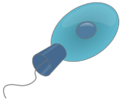ParaHoxozoa facts for kids
Quick facts for kids ParaHoxozoa |
|
|---|---|
| Scientific classification |
|
| Kingdom: | Animalia |
| Subkingdom: | Eumetazoa |
| Clade: | ParaHoxozoa Ryan et al., 2010 |
| Clades | |
ParaHoxozoa is a proposed group of animals that scientists believe are related. It's like a big family tree branch that includes several important animal groups. This group is placed above a phylum (a major animal group) but below a kingdom (the largest group, like the Animal Kingdom).
The ParaHoxozoa group includes animals like Placozoa (very simple, flat creatures), Cnidarians (like jellyfish and sea anemones), and Bilateria (animals that have a body with two symmetrical sides, like humans, insects, and fish).
Contents
What Makes ParaHoxozoa Special?
ParaHoxozoa gets its name from special groups of genes that scientists found in these animals. These genes are called `Hox` and `ParaHox` genes, along with other gene families. Think of these genes as tiny instruction manuals inside an animal's cells. They tell the body how to grow and develop, deciding where the head, tail, and other parts should go.
Scientists study these genes to understand how different animal groups are related to each other. Some scientists thought similar genes might also be in sponges (Porifera). But for now, sponges are not considered part of the ParaHoxozoa group.
How ParaHoxozoa Fits in the Animal Family Tree
Scientists believe that all animals came from a common ancestor. They use different features, including genes, to figure out how animals are related.
The ParaHoxozoa group is thought to have appeared around 680 million years ago. It's a branch on the animal family tree that comes after sponges and comb jellies.
Within ParaHoxozoa, scientists think that Placozoa and Cnidaria are closely related. The Bilateria, which are animals with two symmetrical sides, are another major branch within ParaHoxozoa.
Scientists are still learning about where exactly to place Placozoa on this family tree. They think it might be a "sister" group to all other ParaHoxozoa, or perhaps a sister group only to Cnidaria.
Body Plans: From Simple to Symmetrical
Scientists believe that the first animals with a bilateral body plan (meaning they have two matching sides, like a left and a right) were simple worms. These early worms likely lived on the bottom of the ocean.
These early bilateral animals might have had only one opening in their body. This single opening would have served as both a mouth for eating and an anus for getting rid of waste. Later, animals developed a "through-gut," which is a tube-like digestive system with two openings: a mouth at one end and an anus at the other. This is like the digestive system in earthworms or humans.
Some scientists think that this through-gut might have developed when the single opening in an animal's body closed in the middle, creating two separate openings. For example, some simple worms called Acoela look similar to the young forms (called `planula` larvae) of some cnidarians.
See also
 In Spanish: ParaHoxozoa para niños
In Spanish: ParaHoxozoa para niños
Images for kids







